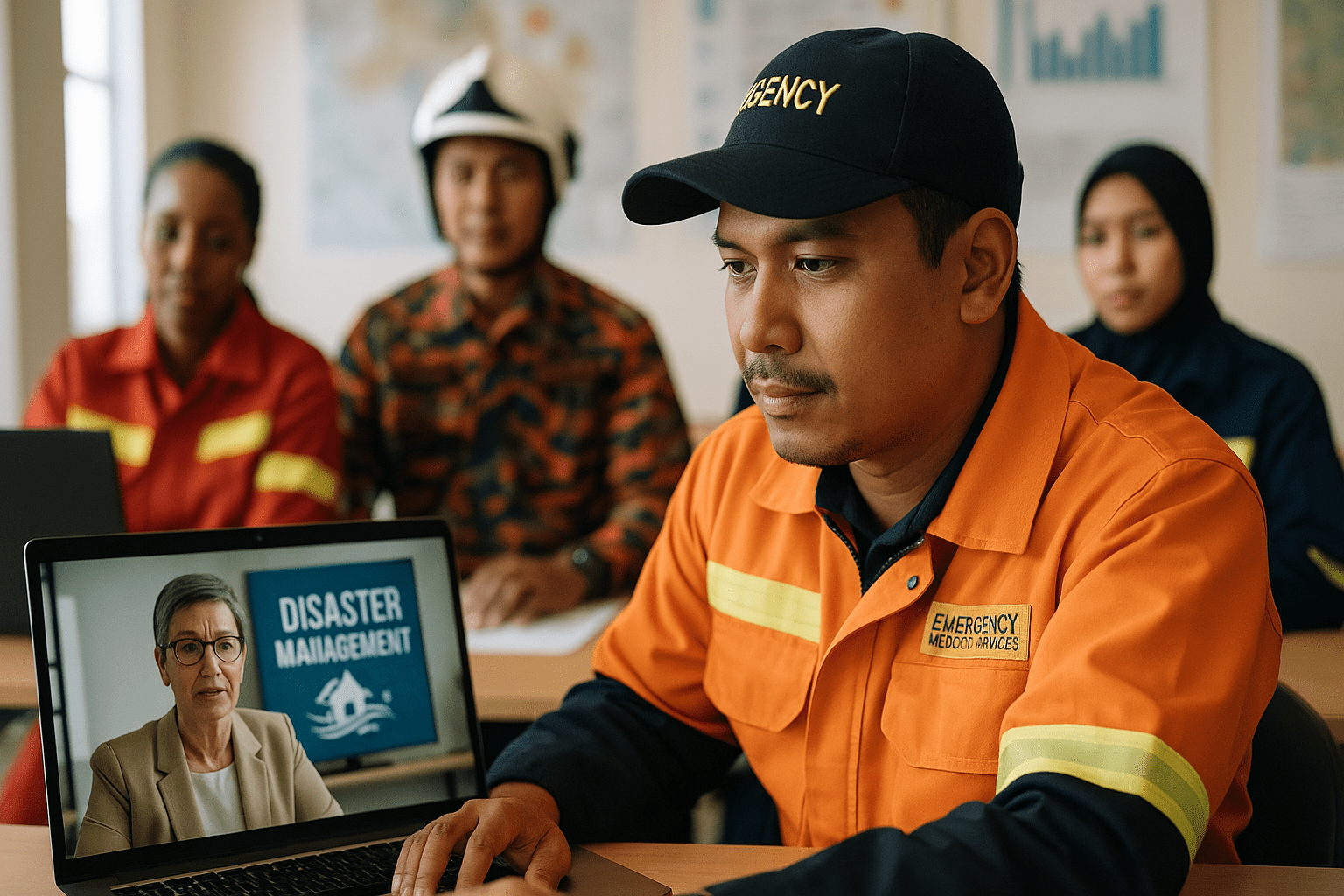Moodle™ Disaster Training That Saves Lives
When nature strikes, there’s no pause button. That’s why disaster training—especially using virtual platforms like Moodle software—has become essential for governments across the Asia-Pacific, but building a scalable, multilingual, flexible learning solution? That’s trickier than it sounds. In this case study, we’ll show how Pukunui and the Pacific Disaster Center (PDC) used a Moodle-based solution to rapidly and efficiently skill up emergency teams in Indonesia, in local languages. Spoiler alert: It worked so well, they expanded across the region.
Transforming Disaster Readiness into Scalable Training Courses
When the PDC asked Pukunui to digitise its instructor-led emergency response training for regional governments, the goal was clear: deliver effective learning on a Moodle™ site without overwhelming the learners or their internet connections. To achieve this, Pukunui developed interactive modules that encouraged participation while being mindful of bandwidth limitations. By leveraging multimedia resources and engaging scenarios, they succeeded in building skills at scale without sacrificing the quality of the training experience. This innovative approach ensured that regional governments could effectively prepare their personnel for emergency response situations, regardless of their technological capabilities.
- We started by designing modular courses using Moodle™ Book activities and built-in media tools.
- Each disaster response course was broken into short, manageable topics with embedded videos, diagrams, and interactive quizzes.
- The system included built-in tracking to monitor staff progress and issue course completion certificates.
The result? An online training environment that made disaster readiness feel a little less, well… disastrous.
Multilingual Access for Southeast Asia’s Disaster Responders
Once the content was ready in English, we didn’t stop there. We translated and adapted the course library into Bahasa Indonesia, boosting engagement and completion rates across government agencies. Language matters when you’re teaching someone how to evacuate a flood zone, and we weren’t about to let poor translations slow anyone down.
Training Without Borders (or Bandwidth Limitations)
Not every learner has fibre internet or a high-end device. That’s why our Moodle™ implementation was optimized explicitly for low-bandwidth environments and mobile-responsive design. The system allowed learners to join virtual classrooms, download resources for offline use, and access quizzes from a desktop or a phone.
Assessment-Driven Learning, Not Passive Clicking
We take assessments seriously, but we also make them engaging. Each training module included:
- Low-stakes quizzes with drag-and-drop and image-based questions
- Automated feedback logic that adapts content delivery
- Instant, personalised certification for those who passed
That’s course management that works because disaster training isn’t about memorising facts-it’s about decision-making when seconds count.
Government-Approved and Growing Fast
Indonesia’s National Disaster Management Agency gave the platform its formal endorsement, and subsequent partnerships have spread the project to the Philippines, Thailand, Laos, and Vietnam. Turns out, when your LMS is purpose-built using Moodle™ software and tailored precisely for real-world users, it scales beautifully. This expansion highlights the versatility of the program, demonstrating how effective LMS training solutions in Malaysia can be adapted to meet diverse regional needs. As more countries adopt this model, the potential for improved disaster response and management grows exponentially. Collaborative efforts are now underway to enhance the platform further, ensuring that it remains a vital resource in crisis preparedness across the Southeast Asian region.
Why This Style of Moodle™ Site Works for Disaster Preparedness
This wasn’t just another Moodle™ setup. It was:
- Flexible: Supporting face-to-face, virtual, and blended delivery
- Efficient: Reducing trainer time and travel costs
- Manageable: Standardised, measurable, and organisation-wide
Bonus benefit? When COVID-19 grounded international travel, Indonesia’s government already had a trained virtual workforce.
Practical Tips for Setting Up Moodle™ Disaster Education Platforms
If you’re building, updating, or expanding a Moodle™-based training program for disaster response, here are a few things to keep in mind:
- Use role-based access to customise dashboards by learner type, first responders need different tools than decision-makers.
- Automate quiz logic to deliver review material automatically when learners miss key concepts.
- Include multimedia like evacuation scenario videos or Red Cross case studies to deepen understanding.
- Test for low-bandwidth: Always assume someone is accessing courses on mobile in a storm-struck region.
- Include frequent checkpoints, such as small quizzes, reflective prompts, and downloads, which all reinforce learning.
Key Takeaway
Moodle™-based disaster training isn’t about flashy features. It’s about building a virtual learning management system that’s user-friendly in high-stress, low-resource contexts. The collaboration between PDC and Pukunui proves it can be done and replicated.
Thinking of adapting or launching a Moodle™ platform in your disaster education program? Talk to us at Pukunui. We’ll help you train your teams before the next warning siren goes off.
FAQs About Moodle Disaster Training
What is Moodle disaster training?
It’s a structured learning program delivered using the Moodle™ software platform that prepares individuals and agencies for disaster response. Courses typically include emergency procedures, disaster risk management, scenario-based simulations, and interactive assessments.
Can Moodle be used for emergency responder education?
Absolutely. Moodle™ software is highly adaptable for disaster response training. It supports self-paced modules, live virtual classrooms, multilingual delivery, and mobile learning for field teams.
How can Moodle help manage large-scale disaster training programs?
The Moodle™ platform allows administrators to track user progress, manage enrolment, organise content by region or role, and automatically reward completion with certificates-all from a central, secure dashboard. Additionally, the platform ensures that sensitive user data is handled with utmost care, adhering to strict privacy regulations. This commitment fosters trust among users and institutions alike, making Moodle work for privacy while providing a seamless learning experience. With customizable privacy settings, administrators can easily control data access and maintain compliance.
Is Moodle suitable for low-bandwidth or remote regions?
Yes, Moodle software can be configured for offline access, mobile responsiveness, and minimal file sizes, making it ideal for rural or disaster-stricken areas with limited internet access.
How do you assess effectiveness in Moodle disaster training programs?
Through formative and summative quizzes, role-play exercises, scenario simulations, and learner feedback surveys, all of which Moodle™ software supports within its course management tools.

